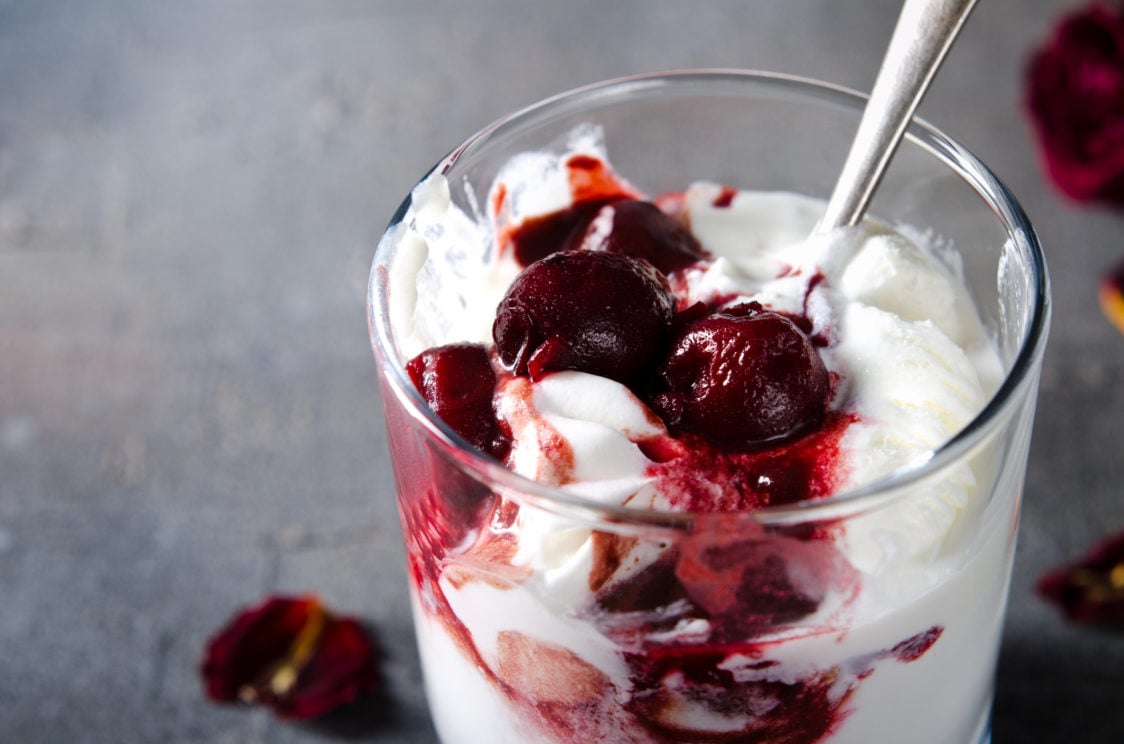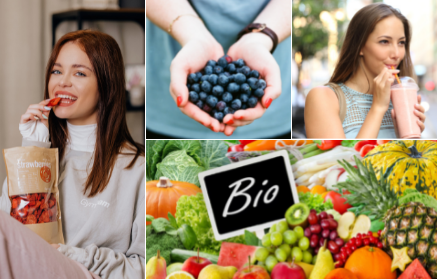Table of Contents
Fruit is an affordable food that has been around for thousands of years. Children learn from infancy how healthy it is and that it should be an everyday part of a balanced diet. However, despite its reputation, fruit has become the target of many myths in recent years, which have caused many people to stop eating it. In today’s article, we will focus on what misleading information is being disseminated about fruit and set the record straight.
Myth 1: Fruit contains sugar, which is why it makes you put on weight
This myth has probably begun to spread among a community of people who feel that only bad sugar is responsible for gaining weight. Our model wife, Edwina, is part of this group. Since sugar is naturally present in fruit, she cut it out of her diet, as well as many other sweets she had previously been eating. What happens next? One of the following scenarios are likely to occur:
Possibility 1:
Edwina has a diet built on sugar. She loves pastries, sweets, chocolates, fruit, cupcakes and strawberry dumplings. When sugar in all its forms is cut from her diet, she doesn’t know what to eat. She discovers that meat and cottage cheese do not contain sugar, so these ingredients start to form the basis of her diet.
What happens? She falls into a calorie deficit and loses weight. But Edwina doesn’t know what an energy balance is so she believes that she lost weight by eliminating ‘bad’ sugar.
What follows next? This strict diet can’t last long. She’ll quit the strict diet sooner or later and return to her old habits. The shed kilos will come back, and a few more on top of that. This, once again, reinforces the misconception that sugar is responsible for gaining weight.
Possibility 2:
Edwina starts avoiding sugar and replaces it with fat. She had read that with a low carbohydrate or ketogenic diet, weight loss was best. Instead of 20g of jam, which can have about 50 kcal, she puts 20g of 100 per cent peanut butter on her protein pancakes. However, this has 120 kcal, which is approximately 2.5 times higher. She also starts replacing fruit. Instead of 100g of apple, which has 61 kcal, she’ll have 30g of cashew nuts although they have 165 kcal. [1]
What will happen? With these replacements, Edwina will inadvertently increase her intake, causing weight gain.
What follows next? Edwina decides she’s a lost cause and nothing works for her. Returning resignedly to her normal diet, she tells her friend over a coffee and cupcake that her metabolism may be malfunctioning.
How is it in reality?
It is true that we find naturally occurring sugar in fruit. Specifically, sucrose disaccharide and glucose monosaccharides and fructose. But it also contains water, minerals, vitamins, antioxidants, and fibre, which cannot be said for ultra-processed sweets. It is also important to mention that glucose and fructose in fruit bind to fibre, which also slows the increase in blood sugar levels. With stable glycaemic levels, you won’t have a reach for something yummy so often. It is therefore best to eat fruit as a whole and not to get rid of the skin (for example, for pears or apples). [2]
It is not only sugar that determines whether a person loses weight or gains weight. It’s too small a fish for that. Energy balance plays a major role. If Edwina eats more energy in general than her body can burn during the day, she will gain weight. And it doesn’t matter if she eats fruit or not. Given the calorie content, however, you might want to think twice about what you enjoy: 100g strawberries – 32 kcal X 100g milk chocolate – 532 kcal.
Perhaps the results of scientific research will convince you of the benefits of fruit. According to these, we achieve the greatest health benefits from fruit and vegetables at an intake of 800g per day. This amount is then linked to prevention of heart and blood vessel diseases. And, as we know, these problems often afflict obese or overweight people. So there is no need to be afraid of fruit even if you already have an extra kilo onboard. [3]

Myth 2: In the afternoon and evening, fruit automatically adds weight
This myth is not as strict on fruit intake as the previous one. It does not completely forbid eating it, but draws attention to the apparent danger of eating it in the afternoon and evening.
So how would an apple behave according to the time Edwina eats it?
- Apple at 10 am: “Perfect time to eat me. I will do everything I can to give Edwina maximum energy for all the activities that await her.”
- Apple at 8:00 pm: “Hmmm, stuffing yourself with me this late at night? Edwina, you should be ashamed. I’ll give it back to you and store it all in the form of fat. You’ll stare in wonder!”
Does this look like a real scenario to you? Me either, even Edwina doesn’t seem to think so, when she truly thinks about it.
How is it in reality?
This myth is probably based on the erroneous reasoning that if you eat fruit in the afternoon or evening, you might not have much of an outlet for the rest of the day, so you get the impression that you would gain weight from it. Fruit sugar is an almost instantaneous source of energy. That doesn’t mean it’s fatty if you don’t go and exercise right away. Again, the energy surplus ultimately determines the storage of excess energy. If you eat more calories than you need to maintain weight, the excess energy from the fruit will be stored. But so would excess energy from meat, rice, vegetables, or a miracle diet shake. [4]
Perhaps, then, Edwina should reconsider. Is it really the banana for an afternoon snack or handful of blueberries after dinner that is cause for her extra kilos? Or is it the pecan pastry for breakfast downed with a pumpkin latte with whipped cream that is at fault? It may surprise you that these two goodies can add up to 800 kcal.

Myth 3: Fruit is best in the form of a detox juice or smoothie
Do you, like Edwina, fall amongst those people drawn to anything that says detox, cleansing, or weight loss? What about when Edwina walks past a fruit juice stand where she sees a detox cleansing weight-loss drink? That’s when her wallet opens on its own, and she feels she just has to have this, no matter what it takes. Who wouldn’t want to cleanse their body of parasites and other negative influences and thus start shedding excess kilos, right?
After drinking it, Edwina feels full of energy and tells herself that it is finally starting to work. She even feels, thanks to the surge of new energy, that she might even go for an afternoon workout. But why, she’s already had that skinny detox drink for dessert, she’s tried hard enough today.
Is a detox drink or any other fruit juice or smoothie much better than a classic fresh apple or pear?
How is it in reality?
If you’re looking for what all sorts of expensive detox smoothies contain, you’re likely to be pretty disappointed. Often you will find only fruit, or celery or spinach, which will take care of the green colour and thus promote the illusion of a miraculous detox. But the surge of energy after drinking a fruity detox smoothie is not caused by Edwina ridding herself of parasites and speeding up her metabolism. The solution is much simpler – the energy received in the form of sugar from the fruit is responsible.
One such detox smoothie from a popular chain contains 2.5 apples, orange, carrot, celery and ginger. It even promises miraculous effects – to rid the body of pollutants, to kick-start and boost the metabolism, to bind to toxic substances thanks to the pectin in apples, and to lead them away from the body with the excess water. At the same time, celery is supposed to clean the digestive system and destroy infections in the kidneys and urinary tract. Unfortunately, reality is different. [5]
Instead of a miraculous drink, you’ll probably get more than 300 kcal and 70g of sugar. In addition, the juice is stripped of fibre and other beneficial substances from the peel. They probably won’t fill you up that much and won’t bind as many pollutants to itself as a whole fruit.
So you’re much better off enjoying a whole piece and the peel than depriving yourself of a large number of beneficial ingredients. Our organs work 24 hours a day to detox, and they really don’t need wannabe miracle drinks to do it.
However, this does not mean that you have to avoid different fruit juices or smoothies. They can be a great help for people who can’t handle solid foods to take in enough calories during the day. A smoothie can also be a good balanced breakfast. All you have to do is reduce the fruit content at the expense of protein and high-quality fats. A blended banana with a little vegetable milk, protein and peanut butter sounds great, doesn’t it? A smoothie like this delivers all the necessary macronutrients, satisfies your taste, and also you.
You might be interested in these products:
Myth 4: Fruit should only be eaten on an empty stomach
Unfortunately, this information also reached Edwina via her close friend. So there was no reason not to believe it. Fruit is said to have a detoxifying effect. The fact that the stomach is empty makes the cleansing effect even greater. Edwina wanted to know more, so she started looking it up on Google.
Another big surprise was some other “advice found” regarding eating fruit on an empty stomach:
- A larger number of pears for breakfast can cause an overly aggressive cleansing effect and irritate the gastric mucosa.
- Eating a banana on an empty stomach can fluctuate potassium levels, unnecessarily burdening the heart.
- Eating citrus fruits on an empty stomach can irritate the stomach, cause heartburn, cause diarrhoea or skin problems.
How is it in reality?
As for detox, we can refer back to the previous point. For example, a drug addict needs a detox, not someone who hasn’t eaten healthily in a few days. Our liver, lungs, skin, lymphatic system and many other organs are taking care of our non-stop detoxification. Without them, not even the consumption of fruit daily could save us.
Also bear in mind that fruit contains the same ingredients in it at all times of the day. The body doesn’t really care when you eat it. Yes, there is chrono – nutrition according to circadian rhythms, which examines the differences in food intake at different times of day. The functioning of so-called morning larks and night owls may thus be slightly different. However, these are not transformational differences that would change your life. If fruit on an empty stomach doesn’t cause you any trouble, then happily do not deny yourself of it. [6-7]
A banana can be a great light breakfast, for example, if you go for a run in the morning and don’t want to go on a completely empty stomach. It will give you energy quickly in the form of natural sugar and will not burden digestion. In addition, if you start eating fruit first thing in the morning, you are more likely to manage to eat enough of it during the day. It is generally recommended for adults to eat around 200g of fruit and 400g of vegetables every day. [6-7]

Myth 5: Frozen, preserved and lyophilised fruits contain no beneficial substances
After reading the previous points, Edwina ceases to be afraid of fruit. But she’s still hesitant about what form is best. Ever since she was a little girl, her parents told her to pick fresh food, that canned food wasn’t healthy. So she thinks fruit is no exception. Similarly, Edwina rejects other forms. For freeze-dried fruit, she assumes that even beneficial substances will disappear. In frozen, she is afraid that nutrients will be destroyed by the low temperature.
How is it in reality?
It may surprise you that fruits described as fresh are also missing beneficial substances. This is particularly the case when you bring it from the shop and leave it at home for a while. It should be noted that it was already stored before it reached the supermarket shelves. During this, it has matured and has slowly begun losing nutrients.
This is not what happens with frozen fruit. It is picked at peak ripeness, when it is frozen. As it does not go through the storage process, it has no time to lose important nutrients. It is typically blanched before freezing. This destroys any micro-organisms that could spoil the fruit. However, all beneficial substances are largely preserved. [8]
The same is true of canned fruit. It also goes through a blanching process. It is then placed in a container of liquid, in which it is heated. Finally, the can is cooled quickly, and the packed fruit is available to the world. As with frozen fruit, the processes used destroy micro-organisms that could spoil the fruit within the can. However, beneficial substances are retained. [9-11]
There is no major nutrient destruction in lyophilization, or freeze drying. In this process, the water content decreases, but the proportion of micronutrients in the fruit does not change significantly. Moreover, the delicious taste and natural aroma remain preserved.
What does that mean? The best option would be to pick the ripe fruit that you have lovingly grown yourself in the garden. However, if you are buying fruit from a supermarket labelled as fresh, this is certainly not a guarantee of the highest nutrient content. You cannot know how long it’s been stored and how many beneficial nutrients it’s lost. So it makes virtually no difference whether you reach for fruit that is frozen, preserved or labelled fresh at the supermarket. [12-14]
It simply pays to keep supplies in the freezer. Just as a bag of lyophilized fruit would not be lost in the pantry. You can add it to porridge, yogurt, desserts, have it as a snack or have it as a healthy snack for in front of the TV.
Myth 6: We should only eat BIO quality fruit
BIO or not BIO? Another area in which Edwina is still unsure. In the shops, BIO fruit is expensive, too expensive by her standards. If it costs more money, it must be better quality, right? In addition, she also read online that fruit, which is not BIO, has a peel full of pesticides and toxic chemicals. So is it really necessary to eat only BIO fruit, or to remove at least the skin from the non BIO apple to eat minimal hazardous substances?
How is it in reality?
BIO refers to fruit that comes from ecological farming. The use of synthetic fertilizers is prohibited during cultivation. The use of agrochemicals, such as pesticides, is also restricted. This is not to say that non BIO fruit is bad or dangerous in any way. If it were different, it couldn’t be sold. The quality of fruit and vegetables is carefully controlled by the competent authorities. [15-17]
So the amount of pesticides contained within the fruit will not harm us. And if you want to reduce their amount in fruit even further, we have a tip for you on how to do it. All you have to do is create an apple bath by mixing water with baking soda (10 mg/ml) and allow the fruit to bathe for 12 minutes. With this process, you should rid of most pesticides. [15-17]
So don’t try to get rid of unwanted substances by peeling the fruit. You would needlessly be deprived of the fibre and other beneficial micronutrients contained in the peel. Even Edwina knows by now that she doesn’t have to worry about any fruit. The supermarket guy simply gets a soda bath. And when she can, she goes to the garden to pick fruit, which is grown in BIO quality by her family.

Myth 7: Fruit is healthy, we can eat as much as we want
Edwina rejoices. She found that sugar was not to be feared, and that fruit alone did not determine whether a person gained weight or lost weight. She also learned that it contains many beneficial substances. So she decided to make the most of fruit and consume a large serving for each course. She says she can eat up to 5 bananas and 300g of mango. But is that a good idea?
How is it in reality?
We already know from previous points how much sugar a simple juice of a few apples and oranges can contain. Just because food is healthy doesn’t mean we should gorge on it from morning till night. Too much of anything is bad, even fruit. If a person ate 5 bananas and 300g of mango every day, they would deliver approximately 915 kcal and 124g of sugar to their body, and that’s a fair amount, isn’t it? It will therefore be better to stick to the recommended intake of 200g of fruit per day.
To give you a better idea of the calorie value of fruit, we have a table with some favourites. [1]
Fruit | Caloric value per 100g |
|---|---|
| Raspberries | 47 kcal |
| Strawberries | 32 kcal |
| Blueberries | 59 kcal |
| Peach | 43 kcal |
| Nectarine | 46 kcal |
| Plums | 54 kcal |
| Cherries | 74 kcal |
| Grapes | 79 kcal |
| Orange | 57 kcal |
| Pineapple | 58 kcal |
| Mango | 70 kcal |
| Banana | 104 kcal |
Myth 8: Diabetics should not eat fruit
Often diabetics are also afraid of fruit, again in the context of scary or bad sugar. But is it really such a threat?
How is it in reality?
Most fruits have a low to moderate glycaemic index, and so are a regular part of the diet for diabetics. A great solution is to mix fruit with cottage cheese or another food that has a low glycaemic index. This produces food that has less influence on blood sugar levels than the fruit itself. It is equally appropriate to select types with a higher fibre content. In general, fruit can be a regular part of a diabetic’s diet. However, if a person has this condition, they always need to discuss their diet individually with their doctor and consult about various classified foods.

What should you remember?
Fruit is great food, and there’s absolutely no need to be afraid of it. Sure, it contains sugar. Unless we’re in total caloric excess, you don’t have to worry about it being stored in the form of fat. You can enjoy it at any time of day. And if you’re in caloric excess, you’re going to store the excess energy. And it doesn’t matter if you eat fruit or not. Even Edwina has finally grasped how it really is with fruit. Next time, she won’t get caught out when her friend recommends a cleanse in the form of a fruity detox smoothie. She prefers to snack on a whole pear with the peel and a protein bar to complement the protein as well.
Do you have anyone among your friends who are afraid of sugar in fruit? If so, don’t forget to share our article with them, so they won’t be deprived of this great food due to some silly myths.
[1] FoodData Central – https://fdc.nal.usda.gov
[2] Elsie May Widdowson, Robert Alexander McCance – The available carbohydrate of fruits – https://www.ncbi.nlm.nih.gov/pmc/articles/PMC1266468/?page=1
[3] Dagfinn Aune et al. – Fruit and vegetable intake and the risk of cardiovascular disease, total cancer and all-cause mortality—a systematic review and dose-response meta-analysis of prospective studies – https://academic.oup.com/ije/article/46/3/1029/3039477
[4] James Hill, Wyatt, H. R., & Peters, J. C. – The Importance of Energy Balance – https://doi.org/10.17925/EE.2013.09.02.111
[5] Detox smoothie – https://www.fruitisimo.cz/vitaminove-koktejly
[6] Pravidlo pěti - zelenina a ovoce 5x denně. Jak je vybírat? – https://www.vimcojim.cz/magazin/clanky/o-vyzive/Pravidlo-peti---zelenina-a-ovoce-5x-denne.-Jak-je-vybirat__s10010x11144.html
[7] Consuming Up To 200 Grams Of Fruits And Vegetables Will Decrease Your Stroke Risk – https://www.medicaldaily.com/consuming-200-grams-fruits-and-vegetables-will-decrease-your-stroke-risk-281612
[8] Giovana Bonat Celli et al. – Influence of freezing process and frozen storage on the quality of fruits and fruit products – https://www.tandfonline.com/doi/abs/10.1080/87559129.2015.1075212?journalCode=lfri20
[9] Ruprich, J. et al. – Blanšírování zeleniny a ovoce je účinný způsob povrchové dekontaminace virů, bakterií i pesticidů – www.szu.cz/uploads/CZVP/Blanching.pdf
[10] Catherine Renard, Jean Francois Maingonnat – Thermal Processing of Fruits and Fruit Juices – https://hal.inrae.fr/hal-02803675/document
[11] Robert C. Wiley – Preservation Methods for Minimally Processed Refrigerated Fruits and Vegetables – https://link.springer.com/chapter/10.1007/978-1-4615-2393-2_3
[12] Ali Bouzari et al. Vitamin retention in eight fruits and vegetables: a comparison of refrigerated and frozen storage – https://pubmed.ncbi.nlm.nih.gov/25526594/
[13] Linshan Li – Selected nutrient analyses of fresh, fresh-stored, and frozen fruits and vegetables – https://www.sciencedirect.com/science/article/abs/pii/S0889157517300418?casa_token=2DRJOFRPj00AAAAA:UtHSl7tdkJvry5CcPAGJJZrhmPDoJeKK42ENIjavrQwEOJ52r3WtraL_wMu6au9Z2LNeMxsq5A
[14] Is there a difference between fresh, frozen, and canned vegetables? – https://examine.com/nutrition/fresh-vs-frozen-vs-canned-vegetables/
[15] Organic Agriculture FAQ [www.fao.org/organicag/oa-faq/en/
[16] The 2016 European Union report on pesticideresidues in food – https://efsa.onlinelibrary.wiley.com/doi/epdf/10.2903/j.efsa.2018.5348
[17] Tianxi Yang Effectiveness of Commercial and Homemade Washing Agents in Removing Pesticide Residues on and in Apples – https://pubs.acs.org/doi/10.1021/acs.jafc.7b03118

